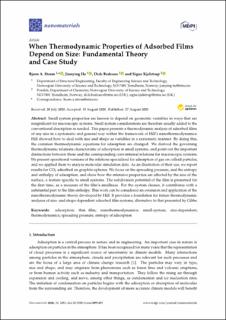| dc.contributor.author | Strøm, Bjørn André | |
| dc.contributor.author | He, Jianying | |
| dc.contributor.author | Bedeaux, Dick | |
| dc.contributor.author | Kjelstrup, Signe | |
| dc.date.accessioned | 2020-09-08T11:27:29Z | |
| dc.date.available | 2020-09-08T11:27:29Z | |
| dc.date.created | 2020-08-20T16:27:26Z | |
| dc.date.issued | 2020 | |
| dc.identifier.citation | Nanomaterials. 2020, 10 (9), . | en_US |
| dc.identifier.issn | 2079-4991 | |
| dc.identifier.uri | https://hdl.handle.net/11250/2676857 | |
| dc.description.abstract | Small system properties are known to depend on geometric variables in ways that are insignificant for macroscopic systems. Small system considerations are therefore usually added to the conventional description as needed. This paper presents a thermodynamic analysis of adsorbed films of any size in a systematic and general way within the framework of Hill’s nanothermodynamics. Hill showed how to deal with size and shape as variables in a systematic manner. By doing this, the common thermodynamic equations for adsorption are changed. We derived the governing thermodynamic relations characteristic of adsorption in small systems, and point out the important distinctions between these and the corresponding conventional relations for macroscopic systems. We present operational versions of the relations specialized for adsorption of gas on colloid particles, and we applied them to analyze molecular simulation data. As an illustration of their use, we report results for CO2 adsorbed on graphite spheres. We focus on the spreading pressure, and the entropy and enthalpy of adsorption, and show how the intensive properties are affected by the size of the surface, a feature specific to small systems. The subdivision potential of the film is presented for the first time, as a measure of the film’s smallness. For the system chosen, it contributes with a substantial part to the film enthalpy. This work can be considered an extension and application of the nanothermodynamic theory developed by Hill. It provides a foundation for future thermodynamic analyses of size- and shape-dependent adsorbed film systems, alternative to that presented by Gibbs. | en_US |
| dc.language.iso | eng | en_US |
| dc.publisher | MDPI | en_US |
| dc.rights | Navngivelse 4.0 Internasjonal | * |
| dc.rights.uri | http://creativecommons.org/licenses/by/4.0/deed.no | * |
| dc.title | When Thermodynamic Properties of Adsorbed Films Depend on Size: Fundamental Theory and Case Study | en_US |
| dc.type | Peer reviewed | en_US |
| dc.type | Journal article | en_US |
| dc.description.version | publishedVersion | en_US |
| dc.source.pagenumber | 20 | en_US |
| dc.source.volume | 10 | en_US |
| dc.source.journal | Nanomaterials | en_US |
| dc.source.issue | 9 | en_US |
| dc.identifier.doi | 10.3390/nano10091691 | |
| dc.identifier.cristin | 1824352 | |
| dc.relation.project | Norges forskningsråd: 234626 | en_US |
| dc.relation.project | Norges forskningsråd: 262644 | en_US |
| dc.relation.project | Notur/NorStore: nn9110k | en_US |
| dc.relation.project | Notur/NorStore: nn9391k | en_US |
| dc.description.localcode | c 2020 by the authors. Licensee MDPI, Basel, Switzerland. This article is an open access article distributed under the terms and conditions of the Creative Commons Attribution (CC BY) license (http://creativecommons.org/licenses/by/4.0/). | en_US |
| cristin.ispublished | true | |
| cristin.fulltext | postprint | |
| cristin.fulltext | original | |
| cristin.qualitycode | 1 | |

